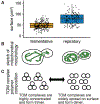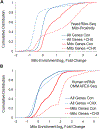Post-transcriptional control of mitochondrial protein composition in changing environmental conditions
- PMID: 33245320
- PMCID: PMC8108647
- DOI: 10.1042/BST20200250
Post-transcriptional control of mitochondrial protein composition in changing environmental conditions
Abstract
In fluctuating environmental conditions, organisms must modulate their bioenergetic production in order to maintain cellular homeostasis for optimal fitness. Mitochondria are hubs for metabolite and energy generation. Mitochondria are also highly dynamic in their function: modulating their composition, size, density, and the network-like architecture in relation to the metabolic demands of the cell. Here, we review the recent research on the post-transcriptional regulation of mitochondrial composition focusing on mRNA localization, mRNA translation, protein import, and the role that dynamic mitochondrial structure may have on these gene expression processes. As mitochondrial structure and function has been shown to be very important for age-related processes, including cancer, metabolic disorders, and neurodegeneration, understanding how mitochondrial composition can be affected in fluctuating conditions can lead to new therapeutic directions to pursue.
Keywords: mRNA; mRNA localization; mRNA translation; mitochondria; mitochondrial morphology; protein import.
© 2020 The Author(s). Published by Portland Press Limited on behalf of the Biochemical Society.
Conflict of interest statement
Competing Interests
The authors declare that there are no competing interests associated with the manuscript.
Figures




Similar articles
-
Posttranscriptional control of mitochondrial biogenesis: spatio-temporal regulation of the protein import process.FEBS Lett. 2010 Oct 22;584(20):4273-9. doi: 10.1016/j.febslet.2010.09.030. Epub 2010 Sep 26. FEBS Lett. 2010. PMID: 20875412 Review.
-
An Essential Role for COPI in mRNA Localization to Mitochondria and Mitochondrial Function.Cell Rep. 2016 Apr 19;15(3):540-549. doi: 10.1016/j.celrep.2016.03.053. Epub 2016 Apr 7. Cell Rep. 2016. PMID: 27068463
-
Mitochondrial volume fraction and translation duration impact mitochondrial mRNA localization and protein synthesis.Elife. 2020 Aug 7;9:e57814. doi: 10.7554/eLife.57814. Elife. 2020. PMID: 32762840 Free PMC article.
-
Localization of mRNAs coding for mitochondrial proteins in the yeast Saccharomyces cerevisiae.RNA. 2011 Aug;17(8):1551-65. doi: 10.1261/rna.2621111. Epub 2011 Jun 24. RNA. 2011. PMID: 21705432 Free PMC article.
-
The ins and outs of the intermembrane space: diverse mechanisms and evolutionary rewiring of mitochondrial protein import routes.Biochim Biophys Acta. 2014 Apr;1840(4):1246-53. doi: 10.1016/j.bbagen.2013.08.013. Epub 2013 Aug 28. Biochim Biophys Acta. 2014. PMID: 23994494 Review.
Cited by
-
Mitochondrial mRNA localization is governed by translation kinetics and spatial transport.PLoS Comput Biol. 2022 Aug 19;18(8):e1010413. doi: 10.1371/journal.pcbi.1010413. eCollection 2022 Aug. PLoS Comput Biol. 2022. PMID: 35984860 Free PMC article.
-
Platelet mitochondria, a potent immune mediator in neurological diseases.Front Physiol. 2023 Sep 1;14:1210509. doi: 10.3389/fphys.2023.1210509. eCollection 2023. Front Physiol. 2023. PMID: 37719457 Free PMC article. Review.
-
Heme sensing and trafficking in fungi.Fungal Biol Rev. 2023 Mar;43:100286. doi: 10.1016/j.fbr.2022.09.002. Epub 2022 Oct 5. Fungal Biol Rev. 2023. PMID: 37781717 Free PMC article.
-
ZNF143 is a transcriptional regulator of nuclear-encoded mitochondrial genes that acts independently of looping and CTCF.Mol Cell. 2025 Jan 2;85(1):24-41.e11. doi: 10.1016/j.molcel.2024.11.031. Epub 2024 Dec 20. Mol Cell. 2025. PMID: 39708805 Free PMC article.
-
Mitochondrial protein heterogeneity stems from the stochastic nature of co-translational protein targeting in cell senescence.Nat Commun. 2024 Sep 27;15(1):8274. doi: 10.1038/s41467-024-52183-y. Nat Commun. 2024. PMID: 39333462 Free PMC article.
References
-
- Scheffler IE. A century of mitochondrial research: Achievements and perspectives. Mitochondrion. 2001;1(1):3–31. - PubMed
-
- Warburg O. On Respiratory Impairment in Cancer Cells. Adv Sci. 1956;124(3215):267–72. - PubMed
-
- De Deken RH. The Crabtree Effect: A Regulatory System in Yeast. J Gen Microbiol. 1966;44(2):149–56. - PubMed
-
- Hock MB, Kralli A. Transcriptional Control of Mitochondrial Biogenesis and Function. Annu Rev Physiol. 2009; - PubMed

